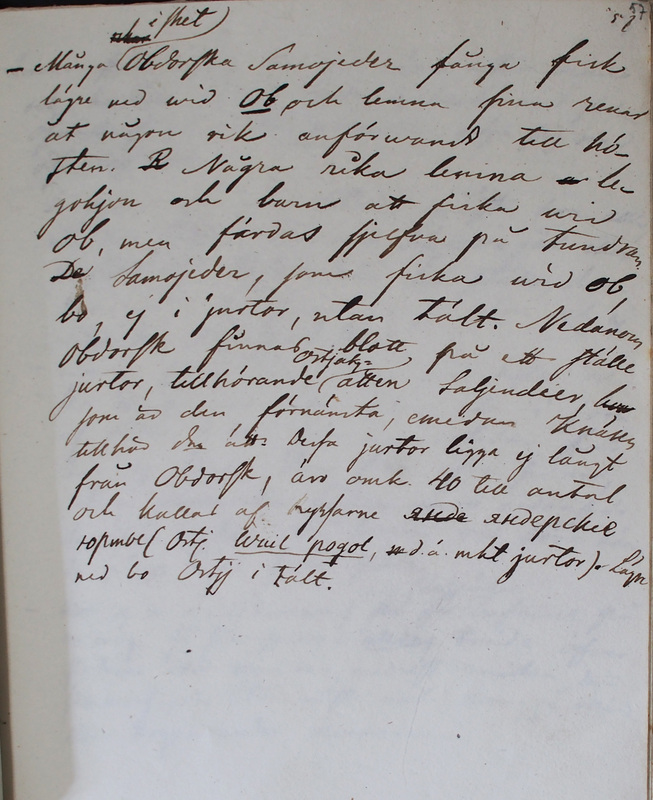Ethnographiska, historiska och statistiska anmärkningar. 057
Title
Ethnographiska, historiska och statistiska anmärkningar. 057
Description
| Många i s[ynner]het Obdorska Samojeder fånga fisk lägre ned wid Ob och lemna sina renar åt någon rik anförwandt till hösten.
See [af andra Samojj.].
Några rika lemna le- gohjon och barn att fiska wid Ob, men färdas sjelfva på tundran. De Samojeder, som fiska wid Ob, bo ej i jurtor,
utan tält. NedanomRu jurta denotes a log cabin without a ceiling used by small-scale reindeer herders, fishermen, and hunters of Western Siberia (Castrén 1852: 318).
Obdorsk finnas blott på ett ställe jurtor, tillhörande Ostjak= ätten Saljendeer, som är den förnämsta, emedan Knäsen
tillhör dna[denna] ätt. Dessa jurtor ligga ej långtThe indigenous chiefs, especially Khanty, Mansi, and Selkup ones, were customarily called princes, Ru knjazec, a practice dating to the pre-Russian colonial era. The Nenets chiefs were called knjazec or staršina ʻchief’. In the Russian colonial administrative system, the princes or chiefs acted as intermediaries between the Tsarist administration and the indigenous population, and their main task was taking care of the collection of tax, yasak. Additionally, they had a right to hand down decisions in local disputes. Lately, Perevalova has argued that the chiefs also had religious power inside the indigenous communities. The position was customarily handed down in a family, which is why some families, such as the Tajšins and Artanzeevs, could be called aristocratic. (Castrén 1852: 299–300; Forsyth 1992: 28–47; Lëzova 2000; Alekseev (ed.) 2010: 31, 117–136; Perevalova 2019)
från Obdorsk, äro omk[ring]. 40 till antal och kallas af Ryssarne яндерскiе юрты
This most probably refers to the Jendyrskie jurty, the place where the Khanty Endyrev and Jermakov families lived. They were part of what was known as Kanasʹ jex ‘princely community’, which also included the Tajšin family, among others. Some Khanty families living near the mouth of the River Obʹ are described as “Nenetsified” by several travellers. This refers to communities that spoke Khanty or were bilingual Khanty and Tundra Nenets speakers and who were nomadic large-scale reindeer herders – not like other Khanty who lived on fishing, hunting, and small-scale reindeer herding. According to Perevalova, the princely community was also called Пульнавыт ëх ‘Community of the mouth of the River Poluj’; in Tundra Nenets Саляндер ʻinhabitants of the cape’. (Perevalova 2004: 192–194; Perevalova 2021; Alekseev (ed.) 2010: 243; Castrén 1852: 312–314)
(Ostj. Wuil pogol, d[et].ä[r]. mkt[mycket] jurtor). Lägre ner bo Ostj[aker]. i tält. |
Many, especially the Obdorsk Samoyeds, fish lower down by the River Ob' and leave their reindeer with some rich relative until the autumn. Some rich people leave their workers and children to fish by the River Ob', and themselves travel in the tundra. Those Samoyeds who fish by the Ob' do not live in yurts, but in tents. Below Obdorsk there are yurts in only one place, and they belong to the Ostyak Saljendeer family. This family is the most aristocratic, because the prince (knjaz') belongs to the family. These yurts are not far away from Obdorsk; they are around 40 in number and the Russians call them janderskie jurty (Ostyak Wuil pogol, i.e. many yurts). Lower down, the Ostyaks live in tents. |

